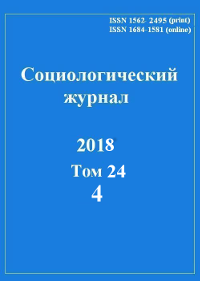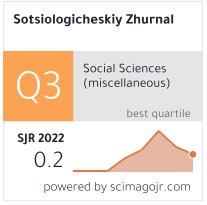Social Order and Practical Wisdom of Walking in a Crowd
Abstract
References
Bourdieu P. Practical Sense. [Russ. ed.: Prakticheskii smysl. Transl. from French by A.T. Bikbov, K.D. Voznesenskaya, S.N. Zenkin, N.A. Shmatko; Ed. by N.A. Shmatko. St Petersburg: Aleteiya publ., 2001. 563 p.] (In Russ.)
Weber M. Economy and Society. Vol. 1: Sociology. [Russ. ed.: Khozyaistvo i obshchestvo. T. 1: Sotsiologiya. Ed. by L.G. Ionin. Moscow: Izd. dom Vysshei shkoly ekonomiki publ., 2016. 446 p.] (In Russ.)
Husserl E. Logical Investigations. Vol. II (1). [Russ. ed.: Logicheskie issledovaniya. Vol. II (1). Transl. from Germ. by V.I. Molchanov. Moscow: Gnozis, Dom intellektual'noi knigi publ., 2001. 472 p.] (In Russ.)
Gusserl' E. Ideas Pertaining to a Pure Phenomenology and to a Phenomenological Philosophy. First Book. [Russ. ed.: Idei k chistoi fenomenologii i fenomenologicheskoi filosofii. Kniga pervaya. Transl. from Germ. by A.V. Mikhailov. Moscow: Akademicheskii proekt publ., 2009. 490 p.] (In Russ.)
Zimmel G. The Metropolis and Mental Life. Transl. from Germ. by A. Krichevskii. Logos. 2002. No. 3. P. 1–12. (In Russ.)
Lebon G. Psychology of Crowds. Transl. from French by A. Fridman, E. Pimenova. Psychology of Crowds. [Russ. ed.: Psikhologiya tolp. Select. by A.K. Bokovikov. Moscow: KSP+ publ., 1998. P. 13–254.] (In Russ.)
Merlo-Ponti M. The Phenomenology of Perception. [Russ. ed.: Fenomenologiya vospriyatiya. Ed. by I.S. Vdovina, S.L. Fokin. St Petersburg: Yuventa; Nauka, publ., 1999. 608 p.] (In Russ.)
Mikhailovskii N.K. Heroes and the Crowd. Geroi i tolpa: izbrannye trudy po sotsiologii v 2-kh t. Vol. 2. [Heroes and the Crowd: Selected Works in Sociology. Vol. 2.] St Petersburg: Aleteiya publ., 1998. P. 5–92. (In Russ.)
Moskovichi S. The Age of the Crowd: A Historical Treatise on Mass Psychology. [Russ. ed: Vek tolp: istoricheskii traktat po psikhologii mass. Transl. from French. T.P. Emel'yanova. Moscow: KSP+ publ., 1998. 480 p.] (In Russ.)
Reinhold G. Smart Mobs: The Next Social Revolution. [Russ. ed.: Umnaya tolpa: novaya sotsial'naya revolyutsiya. Transl. from Eng. by A. Gar'kavyi. Moscow: FAIR-PRESS publ., 2000. 515 p.] (In Russ.)
Sigele S. The Criminal Crowd: An Essay in Collective Psychology. Transl. from French by A.P. Afanas'ev. The Criminal Crowd. [Russ. ed.: Prestupnaya tolpa. Select. by A.K. Bokovikov. Moscow: KSP+ publ., 1999. P. 13–199.] (In Russ.)
Tarde G. Opinion and the Crowd. Ed. by P.S. Kogan. Psychology of Crowds. [Russ. ed.: Psikhologiya tolp. Psychology of Crowds. Select. by A. K. Bokovikov. Moscow: KSP+ publ., 1998. P. 255–408.] (In Russ.)
Tönnies F. Community and Civil Society: Fundamental Concepts in Pure Sociology. [Russ. ed.: Obshchnost' i ob-shchestvo: osnovnye ponyatiya chistoi sotsiologii. Transl. from Germ. by. D.V. Sklyadnev. St Petersburg: Vladimir Dal' publ., 2002. 452 p.] (In Russ.)
Borch Ch. The Politics of Crowds: An Alternative History of Sociology. N.Y.: Cambridge University Press, 2012. 338 p. DOI: 10.1017/CBO9780511842160
Collins R. Violence: A Micro-Sociological Theory. Princeton: Princeton University Press, 2008. 563 p.
Crowds. Ed. by J.Th. Schnapp, M. Tiews. Stanford: Stanford University Press, 2006. 439 p.
Drury J., Stott C.J.T. Crowds in the 21st Century: Perspectives from Contemporary Social Science. N.Y.: Routledge, 2013. 196 p.
Dunne J. Back to the Rough Ground: Practical Judgment and the Lure of Technique. Notre Dame: University of Notre Dame Press, 1997. 492 p.
Easley D., Kleinberg J. Networks, Crowds, and Markets: Reasoning About a Highly Connected World. N.Y.: Cambridge University Press, 2010. 727 p. DOI: 10.1017/CBO9780511761942
Flyvbjerg B. Making Social Science Matter: Why Social Inquiry Fails and How it Can Succeed Again. Oxford: Cam-bridge University Press, 2001. 204 p. DOI: 10.1017/CBO9780511810503
Garfinkel H. Ethnomethodology’s Program: Working Out Durkheim’s Aphorism. Lanham: Rowman & Littlefield, 2002. 299 p.
Garfinkel H. Lebenswelt Origins of the Sciences: Working out Durkheim’s Aphorism — Book Two: Workplace and Documentary Diversity of Ethnomethodological Studies of Work and Sciences by Ethnomethodology’s Authors: What Did We Do? What Did We Learn? Human Studies. 2007. Vol. 30. No. 1. P. 9–56. DOI: 10.1007/s10746-007-9046-9
Goffman E. Relations in Public: Microstudies of the Public Order. N.Y.: Basic Books, 1971. 396 p.
Helbing D., Buzna L., Johansson A., Werner T. Self-Organized Pedestrian Crowd Dynamics: Experiments, Simulations, and Design Solutions. Transportation Science. 2005. Vol. 39. No. 1. P. 1–24. DOI: 10.1287/trsc.1040.0108
Hughes H. Crowd and Mass Behavior. Boston: Allyn & Bacon, 1972. 227 p.
Lofland L.H. The Public Realm: Quintessential City Life. N.Y.: Walter de Gruyter, 1998. 305 p.
Lynch M. Scientific Practice and Ordinary Action: Ethnomethodology and Social Studies of Science. N.Y.: Cambridge University Press, 1993. 333 p.
McPhail C. The Myth of the Madding Crowd. N.Y.: de Gruyter, 1991. 265 p.
McPhail C. The Crowd and Collective Behavior: Bringing Symbolic Interaction Back In. Symbolic Interaction. 2006. Vol. 29. No. 4. P. 433–464. DOI: 10.1525/si.2006.29.4.433
McPhail C., Wohlstein R.T. Individual and Collective Behaviors within Gatherings, Demonstrations, and Riots. Annual Review of Sociology. 1983. Vol. 9. P. 579–600. DOI: 10.1146/annurev.so.09.080183.003051
McPhail C., Wohlstein R.T. Collective Locomotion as Collective Behavior. American Sociological Review. 1986. Vol. 51. No. 4. P. 447–463. DOI: 10.2307/2095580
Park R.E. The Crowd and the Public. The Crowd and the Public and Other Essays. Chicago: University of Chicago Press, 1972. P. 1–81.
Phronesis as Professional Knowledge: Practical Wisdom in the Professions. Ed. by E.A. Kinsella, A. Pitman. Rotter-dam: Sense, 2012. 177 p.
Sandine A. The Taming of the American Crowd: From Stamp Riots to Shopping Sprees. N.Y.: Monthly Review Press, 2009. 272 p.
Schweingruber D.S., McPhail C. A Method for Systematically Observing and Recording Collective Action. Sociological Methods and Research. 1999. Vol. 27. No. 4. P. 451–498. DOI: 10.1177/0049124199027004001
Simmel G. Fundamental Problems of Sociology (Individual and Society). The Sociology of Georg Simmel. Ed. by K.H. Wolff. N.Y.: Free Press, 1950. P. 1–84.
Torres E.C. Durkheim’s Concealed Sociology of the Crowd. Durkheimian Studies. 2014. Vol. 20. P. 89–114.
Wright S. Crowds and Riots: A Study in Social Organization. Beverly Hills: Sage, 1978. 207 p.
The right of authorship belongs to the authors of articles. The authors transfer the rights to use the article (including the use and distribution of an article in the Open Access) to the publisher of the journal on a non-exclusive license (Publishing Agreement (Public Offer))











